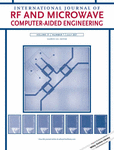Q-band dual-mode substrate integrated waveguide filter and diplexer with circular cavity
Funding information: National Natural Science Foundation of China, Grant/Award Numbers: 61671149, 61861136002
Abstract
This paper proposes novel dual-mode substrate integrated waveguide (SIW) filter and diplexer with circular cavities, in which a pair of symmetrical metallic via perturbations is placed at different positions in a single cavity combining different angle of feeding lines to obtain flexible transmission response. So that multiple transmission zeros can be obtained on one or both sides of the passband. Compared with traditional structure, the proposed dual-mode circular cavity filter and diplexer not only reduce the number of resonators and the volume of filters, but also realize the transmission in higher frequency with the existing machining precision. For verify the structure mentioned above, the dual-mode SIW filter and diplexer are designed, fabricated, and measured in a standard printed circuit board (PCB) process at Q-band. The filter is measured at a central frequency(CF) of 44.86 GHz with a 3 dB fractional bandwidth (FBW) of 10.2%, insertion loss (IL) is 1.9 dB, meanwhile the measured diplexer insertion losses (IL) are 2.1 and 2.4 dB in the lower and upper passbands centered at 38.3 and 44.8 GHz with the fractional bandwidths of 10.7% and 10.1%. The isolation is lower than -40 dB. The measured results show good agreements with the simulated ones.
Open Research
DATA AVAILABILITY STATEMENT
The data that support the findings of this study are available from the corresponding author upon reasonable request.




